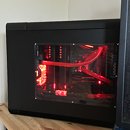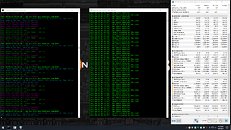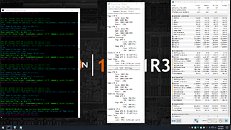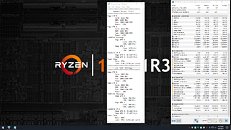Raevenlord
News Editor
- Joined
- Aug 12, 2016
- Messages
- 3,755 (1.23/day)
- Location
- Portugal
| System Name | The Ryzening |
|---|---|
| Processor | AMD Ryzen 9 5900X |
| Motherboard | MSI X570 MAG TOMAHAWK |
| Cooling | Lian Li Galahad 360mm AIO |
| Memory | 32 GB G.Skill Trident Z F4-3733 (4x 8 GB) |
| Video Card(s) | Gigabyte RTX 3070 Ti |
| Storage | Boot: Transcend MTE220S 2TB, Kintson A2000 1TB, Seagate Firewolf Pro 14 TB |
| Display(s) | Acer Nitro VG270UP (1440p 144 Hz IPS) |
| Case | Lian Li O11DX Dynamic White |
| Audio Device(s) | iFi Audio Zen DAC |
| Power Supply | Seasonic Focus+ 750 W |
| Mouse | Cooler Master Masterkeys Lite L |
| Keyboard | Cooler Master Masterkeys Lite L |
| Software | Windows 10 x64 |
AMD's RX Vega is more along the lines of an original computing card that was moved over to the consumer segment for gaming workloads than the other way around. Raja Koduri himself has said something along those lines (extrapolating a little more than what he can actually say), and that much can be gleaned with at least a modicum of confidence through AMD's market positioning and overall computing push. In the argument between gamers and miners, Raja Koduri didn't have all that much to say, but for AMD, a sale is a sale, and it would seem that after some tweaking, RX Vega graphics cards can achieve much increased levels of mining efficiency than their Polaris counterparts, further showing how Vega handles compute workloads much better - and more efficiently - than traditional gaming ones.




Now granted, Vega's strength in mining tasks - Ethereum in particular - stems mainly from the card's usage of HBM2 memory, as well as a wide architecture with its 4096 stream processors. By setting the core clocks to 1000 MHz, the HBM2 memory clock at 1100 MHz, and power target at -24%, Reddit user S1L3N7_D3A7H was able to leverage Vega's strengths in Ethereum's PoW (Proof of Work) algorithm, achieving 43 MH/s with just 130 W of power (104 W of these for the core alone.) For comparison, tweaked RX 580 graphics cards usually deliver around 30 MH/s with 75 W core power, which amounts to around 115 W power draw per card. So Vega is achieving 43% more hash rate with a meager 13% increase in power consumption - a worthy trade-off if miners have ever seen one. This means that Vega 64 beats RX 580 cards in single node hashrate density, meaning that miners can pack more of these cards in a single system for a denser configuration with much increased performance over a similarly specced RX 580-based mining station. This was even achieved without AMD's special-purpose Beta mining driver, which has seen reports of graphical corruption and instability - the scenario could improve for miners even more with a stable release.


Moreover, S1L3N7_D3A7H said he could probably achieve the same mining efficiency on a Vega 56, which isn't all that unbelievable - memory throughput is king in Ethereum mining, so HBm2 could still be leveraged in that graphics card. It seems that at least some of that initial Vega 64 stock went into some miner's hands, as expected. And with these news, I think we'd be forgiven for holding out to our hats in the expectation of increased Vega stock (at the original $499 for Vega 64 and $399 for Vega 56 MSRP) come October. Should the users' claims about RX Vega 56 efficiency be verified, and coeteris paribus in the mining algorithms landscape for the foreseeable future, then we can very much wait for respectable inventory until Navi enters the scene.
View at TechPowerUp Main Site




Now granted, Vega's strength in mining tasks - Ethereum in particular - stems mainly from the card's usage of HBM2 memory, as well as a wide architecture with its 4096 stream processors. By setting the core clocks to 1000 MHz, the HBM2 memory clock at 1100 MHz, and power target at -24%, Reddit user S1L3N7_D3A7H was able to leverage Vega's strengths in Ethereum's PoW (Proof of Work) algorithm, achieving 43 MH/s with just 130 W of power (104 W of these for the core alone.) For comparison, tweaked RX 580 graphics cards usually deliver around 30 MH/s with 75 W core power, which amounts to around 115 W power draw per card. So Vega is achieving 43% more hash rate with a meager 13% increase in power consumption - a worthy trade-off if miners have ever seen one. This means that Vega 64 beats RX 580 cards in single node hashrate density, meaning that miners can pack more of these cards in a single system for a denser configuration with much increased performance over a similarly specced RX 580-based mining station. This was even achieved without AMD's special-purpose Beta mining driver, which has seen reports of graphical corruption and instability - the scenario could improve for miners even more with a stable release.


Moreover, S1L3N7_D3A7H said he could probably achieve the same mining efficiency on a Vega 56, which isn't all that unbelievable - memory throughput is king in Ethereum mining, so HBm2 could still be leveraged in that graphics card. It seems that at least some of that initial Vega 64 stock went into some miner's hands, as expected. And with these news, I think we'd be forgiven for holding out to our hats in the expectation of increased Vega stock (at the original $499 for Vega 64 and $399 for Vega 56 MSRP) come October. Should the users' claims about RX Vega 56 efficiency be verified, and coeteris paribus in the mining algorithms landscape for the foreseeable future, then we can very much wait for respectable inventory until Navi enters the scene.
View at TechPowerUp Main Site
Last edited:








 , I expect next series of Nvidia cards to start at 599$
, I expect next series of Nvidia cards to start at 599$ 




